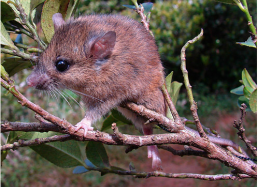6: Reflections on Life in a Cloud Forest
Having reached our second campsite high in the remaining cloud forests of Mt. Pulag, I'm wishing I could send you the videos I've taken of this wonderful place. But since I can't do that until I return to the U.S., let me try to describe it in words.
Imagine yourself in a place where people virtually never go. It's high in the tropic mountains—so high that it's cool, rarely going above 60° F, but rarely dropping below 45° F. The hot, humid air in the lowlands slowly rises up the mountain and cools, and as it cools, clouds condense. These clouds appear to you as dense fog that swirls over the mountain and deep into the forest. Often, the fog and clouds become thick and dark, and rain begins to fall—rain that totals about 6 meters (20 feet) each year. Wind is common, and so the trees are small and sturdy, and often twisted and gnarled (see the above photo).
Moss loves these cool, wet conditions, and so the trees and even the ground are covered by thick layers of moss. The moss is often saturated with water, so that when you brush up against it, it's like brushing against a soaked sponge. When it rains, the moss and thick layer of humus on the ground absorb virtually all of the rain, releasing it slowly into the ground-water.
It's never silent in the forest, but it's rarely noisy—there's usually only a soft sound of wind in the treetops, 10 or 15 feet over your head, and often there's the sound of dripping water or the patter of mist or rain on leaves. When the sun shines, there is a soft, bright green glow that suffuses the forest, but often it's in heavy shade, dark green and brown. At night, within the forest canopy, it seems utterly dark.
Now imagine going into the forest with a flashlight at night. If you're lucky, you may see some of the small animals that live here. If you look carefully, you'll see hundreds of tiny piles of dirt. These are being carefully deposited by earthworms that poke their rear ends above the surface long enough to produce a tiny blob of soil that has passed through their digestive tract.
Suddenly a forest mouse darts in and snatches one of the worms, quickly shucking off the dirt and eating the worm in pieces, which it tears off like a child eating a long string of licorice (see Photo #1 below). Ahead you see some piles of raw soil, and a silver earth-mouse emerges from one, pushing a pile of dirt ahead of it. A worm emerges from the pile, and the mouse quickly grabs and eats it; clearly, earthworms aren't only abundant here, they're a favorite food for lots of critters.
Overhead, you may catch a glimpse of rapid movement. If it stops in the right spot, you may recognize a tiny mouse with reddish fur, a short, broad head, and remarkably long whiskers. It's carrying a hard nut that it totes to a protected spot where it gnaws through the hull to reach the seed that's rich with oil and protein. Seeing this animal gets your heart pounding, for it's the species that was just discovered in 2007 on Mt. Amuyao, and this is only the second place it's known to occur.
Ahead of you, a shadow moves. It's much larger, about the size of a house-cat, and it's dark, nearly black. It carefully moves along the ground then quickly climbs into a small tree to feed on some tender young shoots. It then crosses some vines and limbs to the next tree and back to the ground.
You see now that it's covered with flowing, black fur that's amazingly long, soft, and dense, with hints of lighter fur beneath the black covering. The eyes are large and dark, and the tail is long—longer than the body—and covered with the same long, soft, black fur. It's a giant bushy-tailed cloud rat, an animal that lives only in this wonderful mossy forest, and it's arguably the most beautiful animal in the Philippines (see Photo #2 below).
If this scenario leaves you with the impression that this is my favorite habitat, you're absolutely correct. For me, this is a place of natural magic, filled with life and biological richness. It's full of animals that are both poorly known and full of surprises about how they live—and this is a wonderful combination for naturalists like me, Danny, Joel, and all of the others.
Learning about these animals and the place where they thrive is hard work: it's not easy living in frequently soggy tents and cold rain, spending hours and days hiking in the forest, setting and checking traps, recording data, and keeping one’s basic body functions operating at an adequate level. It's also a source of wonderment, understanding, and something that feels a lot like joy.
More soon,
Larry




